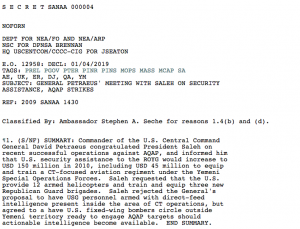Against Legion of Doom Alert, Is Hadi Playing Saleh’s Old Game?
After President Obama met with Yemen’s President Abdo Rabu Mansour Hadi on the eve (or during the progression) of the Legion of Doom alert last week, he said this about Hadi’s cooperation on terrorism.
I thank President Hadi and his government for the strong cooperation that they’ve offered when it comes to counterterrorism. Because of some of the effective military reforms that President Hadi initiated when he came into this office, what we’ve seen is al Qaeda in the Arabian Peninsula, or AQAP, move back out of territories that it was controlling.
And President Hadi recognizes that these threats are not only transnational in nature, but also cause severe hardship and prevent the kind of prosperity for the people of Yemen themselves. [my emphasis]
Hadi responded,
Our work together insofar as countering terrorism is concerned and also against al Qaeda is expressive, first and foremost, of Yemeni interests, because as a result of the activities of al Qaeda, Yemen’s development basically came to a halt whereby there is no tourism, and the oil companies, the oil-exploring companies had to leave the country as a result of the presence of al Qaeda. So our cooperation against those terrorist elements are actually serving the interests of Yemen. [my emphasis]
Note how this carefully scripted puppet show emphasized Yemen’s own interests in defeating al Qaeda.
Here’s what, in the wake of disagreements whether a disrupted plot (that may have had nothing to do with AQAP) had anything to do with the Legion of Doom alert, the WSJ now reports really happened at the meeting between Obama and Hadi.
The U.S. raised concerns in meetings in Washington last week, with officials complaining to President Abd Rabbu Mansour Hadi that Yemeni forces weren’t taking the al Qaeda threat seriously and needed to stop pulling back from military offensives, people familiar with the meetings said. Yemeni officials say they have spared no effort battling al Qaeda and its affiliates but that the threat remains too large for their ill-equipped military.
“We don’t have the capabilities or man power to capture large swaths of territory,” said one Yemeni official familiar with counterterrorism policy. “AQAP has hide-outs in remote villages and towns spread across the country.”
The history of U.S.-Yemeni counterterrorism relations has been checkered with missteps and mistakes, even before this latest terror alert. Mr. Hadi—who came to power in large part due to America’s diplomatic intervention—has tried to strengthen military and economic ties with the U.S.
Some officials in San’a, however, worry that President [my emphasis]
It goes onto lay out details of the cooperation — though the reported influx of JSOC members to Yemen may reflect a dramatic departure from this cooperation.
At the heart of the U.S.-Yemeni cooperation is a joint command center in Yemen, where officials from the two countries evaluate intelligence gathered by America and other allies, such as Saudi Arabia, say U.S. and Yemeni officials. There, they decide when and how to launch missile strikes against the highly secretive list of alleged al Qaeda operatives approved by the White House for targeted killing, these people say.
But local sensitivities about the bilateral counterterrorism cooperation have spiked in recent years due to high-profile civilian deaths by U.S. missiles, prompting tight limitations on any visible American role in the fight against al Qaeda.
For example, U.S. Special Forces aren’t allowed to accompany Yemeni units on patrols through the rugged mountains where al Qaeda cells have found haven, military officials familiar with the situation say. But Yemeni units have neither the skill nor political will to take on these sorts of quick-strike operations, the officials said.
Instead, Yemeni armed forces conduct periodic high-profile land operations against militants whose affiliation with al Qaeda isn’t clear.
And all that’s built on a bunch of military toys which Foreign Policy catalogs here. (Note, why are we paying Gallup $280,000 for a “Yemen Assessment Survey” when they can’t even poll in the US competently anymore? If we insist on using a US firm, why not use Zogby, which would have better ties to Arabic speakers?)
But underlying all this parroted language about cooperation is the reality that a focus on Al Qaeda tends to distract Hadi, who already relies on the US and Brits and Saudis to retain power, from issues that matter to Yemenis. This superb Guardian piece notes how counterterrorism delegitimizes him.
Among ordinary Yemenis, meanwhile, the latest al-Qaida drama has been greeted with scepticism and even some derision. Read more →

